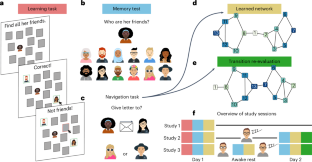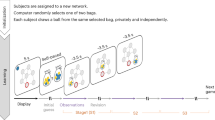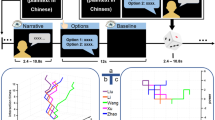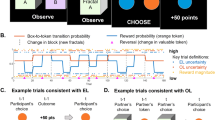Abstract
To make adaptive social decisions, people must anticipate how information flows through their social network. While this requires knowledge of how people are connected, networks are too large to have first-hand experience with every possible route between individuals. How, then, are people able to accurately track information flow through social networks? Here we find that people immediately cache abstract knowledge about social network structure as they learn who is friends with whom, which enables the identification of efficient routes between remotely connected individuals. These cognitive maps of social networks, which are built while learning, are then reshaped through overnight rest. During these extended periods of rest, a replay-like mechanism helps to make these maps increasingly abstract, which privileges improvements in social navigation accuracy for the longest communication paths that span distinct communities within the network. Together, these findings provide mechanistic insight into the sophisticated mental representations humans use for social navigation.
This is a preview of subscription content, access via your institution
Access options
Access Nature and 54 other Nature Portfolio journals
Get Nature+, our best-value online-access subscription
$29.99 / 30 days
cancel any time
Subscribe to this journal
Receive 12 digital issues and online access to articles
$119.00 per year
only $9.92 per issue
Buy this article
- Purchase on SpringerLink
- Instant access to full article PDF
Prices may be subject to local taxes which are calculated during checkout




Similar content being viewed by others
Data availability
All data needed to reproduce the analyses are available in a publicly accessible GitHub repository at https://github.com/feldmanhalllab/network-navigation-replay (ref. 57).
Code availability
All code needed to reproduce the analyses are available in a publicly accessible GitHub repository at https://github.com/feldmanhalllab/network-navigation-replay (ref. 57).
References
Travers, J. & Milgram, S. An experimental study of the small world problem. Sociometry 32, 425–443 (1969).
Christakis, N. A. & Fowler, J. H. Social contagion theory: examining dynamic social networks and human behavior. Stat. Med. 32, 556–577 (2013).
Son, J.-Y., Bhandari, A. & FeldmanHall, O. Cognitive maps of social features enable flexible inference in social networks. Proc. Natl Acad. Sci. USA 118, e2021699118 (2021).
Son, J.-Y., Bhandari, A. & FeldmanHall, O. Abstract cognitive maps of social network structure aid adaptive inference. Proc. Natl Acad. Sci. USA 120, e2310801120 (2023).
Tolman, E. C. Cognitive maps in rats and men. Psychol. Rev. 55, 189–208 (1948).
O’Keefe, J. & Nadel, L. The Hippocampus as a Cognitive Map (Clarendon, 1978).
Hafting, T., Fyhn, M., Molden, S., Moser, M.-B. & Moser, E. I. Microstructure of a spatial map in the entorhinal cortex. Nature 436, 801–806 (2005).
Bellmund, J. L. S., Gärdenfors, P., Moser, E. I. & Doeller, C. F. Navigating cognition: spatial codes for human thinking. Science 362, eaat6766 (2018).
Behrens, T. E. J. et al. What is a cognitive map? Organizing knowledge for flexible behavior. Neuron 100, 490–509 (2018).
Constantinescu, A. O., O'Reilly, J. X. & Behrens, T. E. J. Organizing conceptual knowledge in humans with a gridlike code. Science 352, 1464–1468 (2016).
Garvert, M. M., Dolan, R. J. & Behrens, T. E. J. A map of abstract relational knowledge in the human hippocampal–entorhinal cortex. eLife 6, e17086 (2017).
Tavares, R. M. et al. A map for social navigation in the human brain. Neuron 87, 231–243 (2015).
Park, S. A., Miller, D. S., Nili, H., Ranganath, C. & Boorman, E. D. Map making: constructing, combining, and inferring on abstract cognitive maps. Neuron 107, 1226–1238.e1228 (2020).
Dayan, P. Improving generalization for temporal difference learning: the successor representation. Neural Comput. 5, 613–624 (1993).
Momennejad, I. Learning structures: predictive representations, replay, and generalization. Curr. Opin. Behav. Sci. 32, 155–166 (2020).
Momennejad, I. et al. The successor representation in human reinforcement learning. Nat. Hum. Behav. 1, 680–692 (2017).
Russek, E. M., Momennejad, I., Botvinick, M. M., Gershman, S. J. & Daw, N. D. Predictive representations can link model-based reinforcement learning to model-free mechanisms. PLoS Comput. Biol. 13, e1005768 (2017).
Stachenfeld, K. L., Botvinick, M. M. & Gershman, S. J. The hippocampus as a predictive map. Nat. Neurosci. 20, 1643–1653 (2017).
Lynn, C. W. & Bassett, D. S. How humans learn and represent networks. Proc. Natl Acad. Sci. USA. 117, 29407–29415 (2020).
Lynn, C. W., Kahn, A. E., Nyema, N. & Bassett, D. S. Abstract representations of events arise from mental errors in learning and memory. Nat. Commun. 11, 2313 (2020).
Momennejad, I. & Howard, M. W. Predicting the future with multi-scale successor representations. Preprint at bioRxiv https://doi.org/10.1101/449470 (2018).
Schapiro, A. C., Rogers, T. T., Cordova, N. I., Turk-Browne, N. B. & Botvinick, M. M. Neural representations of events arise from temporal community structure. Nat. Neurosci. 16, 486–492 (2013).
Pudhiyidath, A. et al. Representations of temporal community structure in hippocampus and precuneus predict inductive reasoning decisions. J. Cogn. Neurosci. 34, 1736–1760 (2022).
Foster, D. J. Replay comes of age. Annu. Rev. Neurosci. 40, 581–602 (2017).
Schapiro, A. C., McDevitt, E. A., Rogers, T. T., Mednick, S. C. & Norman, K. A. Human hippocampal replay during rest prioritizes weakly learned information and predicts memory performance. Nat. Commun. 9, 3920 (2018).
Sun, W., Advani, M., Spruston, N., Saxe, A. & Fitzgerald, J. E. Organizing memories for generalization in complementary learning systems. Nat. Neurosci. 26, 1438–1448 (2023).
Liu, Y., Mattar, M. G., Behrens, T. E. J., Daw, N. D. & Dolan, R. J. Experience replay is associated with efficient nonlocal learning. Science 372, eabf1357 (2021).
Foster, D. J. & Wilson, M. A. Reverse replay of behavioural sequences in hippocampal place cells during the awake state. Nature 440, 680–683 (2006).
Igata, H., Ikegaya, Y. & Sasaki, T. Prioritized experience replays on a hippocampal predictive map for learning. Proc. Natl Acad. Sci. USA 118, e2011266118 (2021).
Zhenglong, Z., Michael, J. K. & Anna, C. S. Replay as context-driven memory reactivation. Preprint at bioRxiv https://doi.org/10.1101/2023.03.22.533833 (2023).
Ellenbogen, J. M., Hu, P. T., Payne, J. D., Titone, D. & Walker, M. P. Human relational memory requires time and sleep. Proc. Natl Acad. Sci. USA 104, 7723–7728 (2007).
Lewis, P. A. & Durrant, S. J. Overlapping memory replay during sleep builds cognitive schemata. Trends Cogn. Sci. 15, 343–351 (2011).
Lutz, N. D., Diekelmann, S., Hinse-Stern, P., Born, J. & Rauss, K. Sleep supports the slow abstraction of gist from visual perceptual memories. Sci. Rep. 7, 42950 (2017).
Feld, G. B., Bernard, M., Rawson, A. B. & Spiers, H. J. Sleep targets highly connected global and local nodes to aid consolidation of learned graph networks. Sci. Rep. 12, 15086 (2022).
Klinzing, J. G., Niethard, N. & Born, J. Mechanisms of systems memory consolidation during sleep. Nat. Neurosci. 22, 1598–1610 (2019).
Correa, C. G., Ho, M. K., Callaway, F., Daw, N. D. & Griffiths, T. L. Humans decompose tasks by trading off utility and computational cost. PLoS Comput. Biol. 19, e1011087 (2023).
Callaway, F. et al. Rational use of cognitive resources in human planning. Nat. Hum. Behav. 6, 1112–1125 (2022).
Rigoux, L., Stephan, K. E., Friston, K. J. & Daunizeau, J. Bayesian model selection for group studies—revisited. NeuroImage 84, 971–985 (2014).
Wagenmakers, E.-J. & Farrell, S. AIC model selection using Akaike weights. Psychon. Bull. Rev. 11, 192–196 (2004).
Kurth-Nelson, Z., Economides, M., Dolan, R. J. & Dayan, P. Fast sequences of non-spatial state representations in humans. Neuron 91, 194–204 (2016).
Schuck, N. W. & Niv, Y. Sequential replay of non-spatial task states in the human hippocampus. Science 364, eaaw5181 (2019).
Gómez, R. L., Bootzin, R. R. & Nadel, L. Naps promote abstraction in language-learning infants. Psychol. Sci. 17, 670–674 (2006).
Lau, H., Alger, S. E. & Fishbein, W. Relational memory: a daytime nap facilitates the abstraction of general concepts. PLoS ONE 6, e27139 (2011).
Pereira, S. I. R. et al. Rule abstraction is facilitated by auditory cuing in REM sleep. J. Neurosci. 43, 3838–3848 (2023).
St Clair, M. C. & Monaghan, P. Language abstraction: consolidation of language structure during sleep. In Proc. of the Annual Meeting of the Cognitive Science Society 30 (Cognitive Science Society, 2008).
Walker, M. P. & Stickgold, R. Overnight alchemy: sleep-dependent memory evolution. Nat. Rev. Neurosci. 11, 218 (2010).
Wittkuhn, L., Krippner, L. M. & Schuck, N. W. Replay in human visual cortex is linked to the formation of successor representations and independent of consciousness. Preprint at bioRxiv https://doi.org/10.1101/2022.02.02.478787 (2022) .
Jadhav, S. P., Kemere, C., German, P. W. & Frank, L. M. Awake hippocampal sharp-wave ripples support spatial memory. Science 336, 1454–1458 (2012).
Stoianov, I., Maisto, D. & Pezzulo, G. The hippocampal formation as a hierarchical generative model supporting generative replay and continual learning. Prog. Neurobiol. 217, 102329 (2022).
Gershman, S. J., Moore, C. D., Todd, M. T., Norman, K. A. & Sederberg, P. B. The successor representation and temporal context. Neural Comput. 24, 1553–1568 (2012).
Lau, T., Gershman, S. J. & Cikara, M. Social structure learning in human anterior insula. Elife 9, e53162 (2020).
Whittington, J. C. R. et al. The Tolman–Eichenbaum machine: unifying space and relational memory through generalization in the hippocampal formation. Cell 183, 1249–1263.e1223 (2020).
Wu, C. M., Schulz, E. & Gershman, S. J. Inference and search on graph-structured spaces. Comput. Brain Behav. 4, 125–147 (2021).
Ma, D. S., Correll, J. & Wittenbrink, B. The Chicago face database: a free stimulus set of faces and norming data. Behav. Res. Methods 47, 1122–1135 (2015).
Brooks, M. E. et al. glmmTMB balances speed and flexibility among packages for zero-inflated generalized linear mixed modeling. R J. 9, 378–400 (2017).
Wilson, R. C. & Collins, A. G. E. Ten simple rules for the computational modeling of behavioral data. Elife 8, e49547 (2019).
Network-navigation-replay. GitHub https://github.com/feldmanhalllab/network-navigation-replay (2024).
Acknowledgements
We thank I. Aslarus, K. Danowski, E. Duchan, Y.-F. Jerry Hu, A. Lawrence, J. Palfy, V. Poyraz, M. Malhotra, M. Mazumder, S. Shulman, A. Stein, S. Vaca Narvaja and J. Wang for assisting with data collection. We thank A. Maddah for developing some of the task code used in these studies and Y. Yang Teoh for helpful computational modelling advice. Part of this research was conducted using computational resources and services at the Centre for Computation and Visualization, Brown University. Advanced access to these computing resources was supported by NIH award 1S10OD025181. This work is supported by the National Science Foundation award 2123469 (O.F.H. and A.B.). The funders had no role in study design, data collection and analysis, decision to publish or preparation of the paper.
Author information
Authors and Affiliations
Contributions
J.Y.S. and M.-L.V. contributed equally to this work. A.B. and O.F.H. contributed equally to this work. Conceptualization: M.-L.V., J.Y.S., A.B. and O.F.H. Formal analysis: J.Y.S. and M.-L.V. Funding acquisition: O.F.H. Investigation: M.-L.V. Methodology: M.-L.V., J.Y.S., A.B. and O.F.H. Supervision: O.F.H. and A.B., Writing: J.Y.S., M.-L.V., A.B. and O.F.H.
Corresponding authors
Ethics declarations
Competing interests
The authors declare no competing interests.
Peer review
Peer review information
Nature Human Behaviour thanks Charley Wu and the other, anonymous, reviewer(s) for their contribution to the peer review of this work. Peer reviewer reports are available.
Additional information
Publisher’s note Springer Nature remains neutral with regard to jurisdictional claims in published maps and institutional affiliations.
Supplementary information
Supplementary Information
Supplementary Figs. 1–16, Results and Tables 1–6.
Rights and permissions
Springer Nature or its licensor (e.g. a society or other partner) holds exclusive rights to this article under a publishing agreement with the author(s) or other rightsholder(s); author self-archiving of the accepted manuscript version of this article is solely governed by the terms of such publishing agreement and applicable law.
About this article
Cite this article
Son, JY., Vives, ML., Bhandari, A. et al. Replay shapes abstract cognitive maps for efficient social navigation. Nat Hum Behav (2024). https://doi.org/10.1038/s41562-024-01990-w
Received:
Accepted:
Published:
DOI: https://doi.org/10.1038/s41562-024-01990-w



